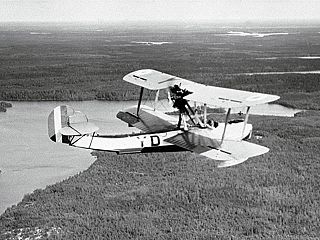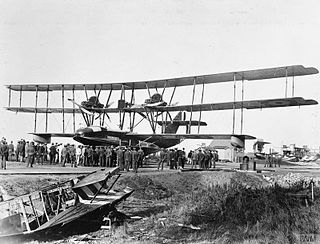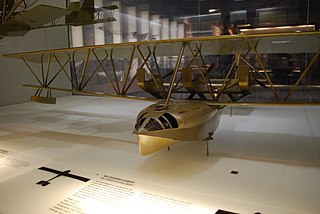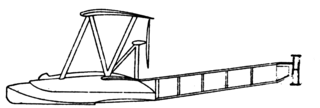
The Bombardier Challenger 600 series is a family of business jets developed by Canadair after a Bill Lear concept, and then produced from 1986 by its new owner, Bombardier Aerospace. At the end of 1975, Canadair began funding the development of LearStar 600, and then bought the design for a wide-cabin business jet in April 1976. On 29 October, the programme was launched, backed by the Canadian federal government, and designed to comply with new FAR part 25 standards.

The Short S.14 Sarafand was a British biplane flying boat built by Short Brothers. It was planned as a general reconnaissance aircraft for military service. When it was built in 1932 it was the largest aeroplane in the United Kingdom.

The twin-engine F5L was one of the Felixstowe F series of flying boats developed by John Cyril Porte at the Seaplane Experimental Station, Felixstowe, England, during the First World War for production in America.

The Canadian Vickers Vedette was the first aircraft designed and built in Canada to meet a specification for Canadian conditions. It was a single-engine biplane flying boat purchased to meet a Royal Canadian Air Force (RCAF) demand for a smaller aircraft than the Vickers Viking with a much greater rate of climb, to be suitable for forestry survey and fire protection work. The type went on to have a long and distinguished career in civil operations in Canada. Most of the topographical maps in use in Canada today are based on photos taken from these aircraft.

The Canadian Vickers Varuna was a Canadian flying boat of the 1920s built by Canadian Vickers as a twin-engined, unequal-span biplane, with a wooden hull and steel tube structure.

The Savoia-Marchetti SM.78 was an Italian bomber/reconnaissance biplane flying boat of the early 1930s.

The Curtiss HS was a single-engined patrol flying boat built for the United States Navy during World War I. Large numbers were built from 1917 to 1919, with the type being used to carry out anti-submarine patrols from bases in France from June 1918. It remained in use with the US Navy until 1928, and was also widely used as a civil passenger and utility aircraft.

The Felixstowe F.4 Fury, also known as the Porte Super-Baby, was a large British, five-engined triplane flying-boat designed by John Cyril Porte at the Seaplane Experimental Station, Felixstowe, inspired by the Wanamaker Triplane/Curtiss Model T. At the time the Fury was the largest seaplane in the world, the largest British aircraft, and the first aircraft controlled successfully by servo-assisted means.
The Fokker B.I was a reconnaissance flying boat built in the Netherlands in 1922. The B.I was followed by an improved version, the B.III in 1926. It was a conventional biplane flying boat design, with staggered sesquiplane wings braced by struts arranged as a Warren truss. The engine was mounted pusher-wise on the top wing. The duralumin hull featured three open cockpits - one at the nose for a gunner, one in front of the lower wing for the pilot and engineer and one behind the wings for another gunner. The B.I was amphibious, equipped with main undercarriage that folded back along the hull, but this feature was omitted in the B.III. The B.I was flown in the Dutch East Indies by the Naval Air Service for a number of years, and although it gave good service, no further examples were ordered from Fokker.

The Fokker F-11 was a luxury flying boat produced as an 'air yacht' in the United States in the late 1920s. Technically the aircraft was the Fokker Aircraft Corporation of America's Model 9. It was sold in North America as the Fokker F-11 and was offered in Europe as the Fokker B.IV. By the time the first six aircraft had been constructed, it was already evident that the design was not going to sell well. A few were sold, two to notable multi-millionaires; Harold Vanderbilt and Garfield Wood each purchasing one. One was bought by Air Ferries in San Francisco. The F-11A cost $40,000 but the price was slashed to $32,500 as the depression set in during 1930. The F-11 was a commercial failure.

The General Aviation PJ was a flying boat produced in the United States in the 1930s as a search-and-rescue aircraft for the Coast Guard.

The Boeing Model 6D, a.k.a. Boeing Model 6E, Boeing B-1D and Boeing B-1E, was an American pusher biplane flying-boat built by Boeing between 1928 and 1929.

The Zeppelin-Lindau Rs.I was a large three-engined biplane flying boat designed by Claudius Dornier and built during 1914–15 on the German side of Lake Constance. It never progressed beyond taxiing trials as it was destroyed in a storm.

The Fairey N.4 was a 1920s British five-seat long range reconnaissance flying boat. Designed and built by the Fairey Aviation Company to meet an Admiralty requirement for a very large four-engined reconnaissance aircraft, it was the world's biggest flying boat when it first flew in 1923.

The Zeppelin-Lindau Rs.II was a biplane flying boat, designed by Claudius Dornier and built during 1914–1915 on the German side of Lake Constance. Initially this aircraft was powered by three engines mounted inside the hull driving three pusher propellers via gearboxes and shafts. The later version was powered by four engines in two push-pull nacelles mounted between the wings.

The Peel Z-1 Glider Boat, also called the Peel Flying Boat, is an American biplane, two-seats-in-tandem, flying boat glider that was designed and produced by the Peel Glider Boat Company, starting in about 1930.
The Aeromarine AMC was the first American all-metal hulled commercial flying boat.
The Aeromarine EO was a light sport flying boat that was built in the mid-1920s.

The Savoia-Marchetti SM.80 was a two-seat monoplane amphibian tourer, with a single, tractor engine mounted above the wing, designed in Italy in the early 1930s. The SM.80bis was a four-seat variant, powered by two pusher engines.

The Albatros L.71 was a two-seat, single pusher engined biplane built in Germany in the 1920s.





















